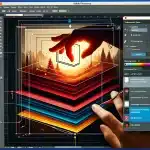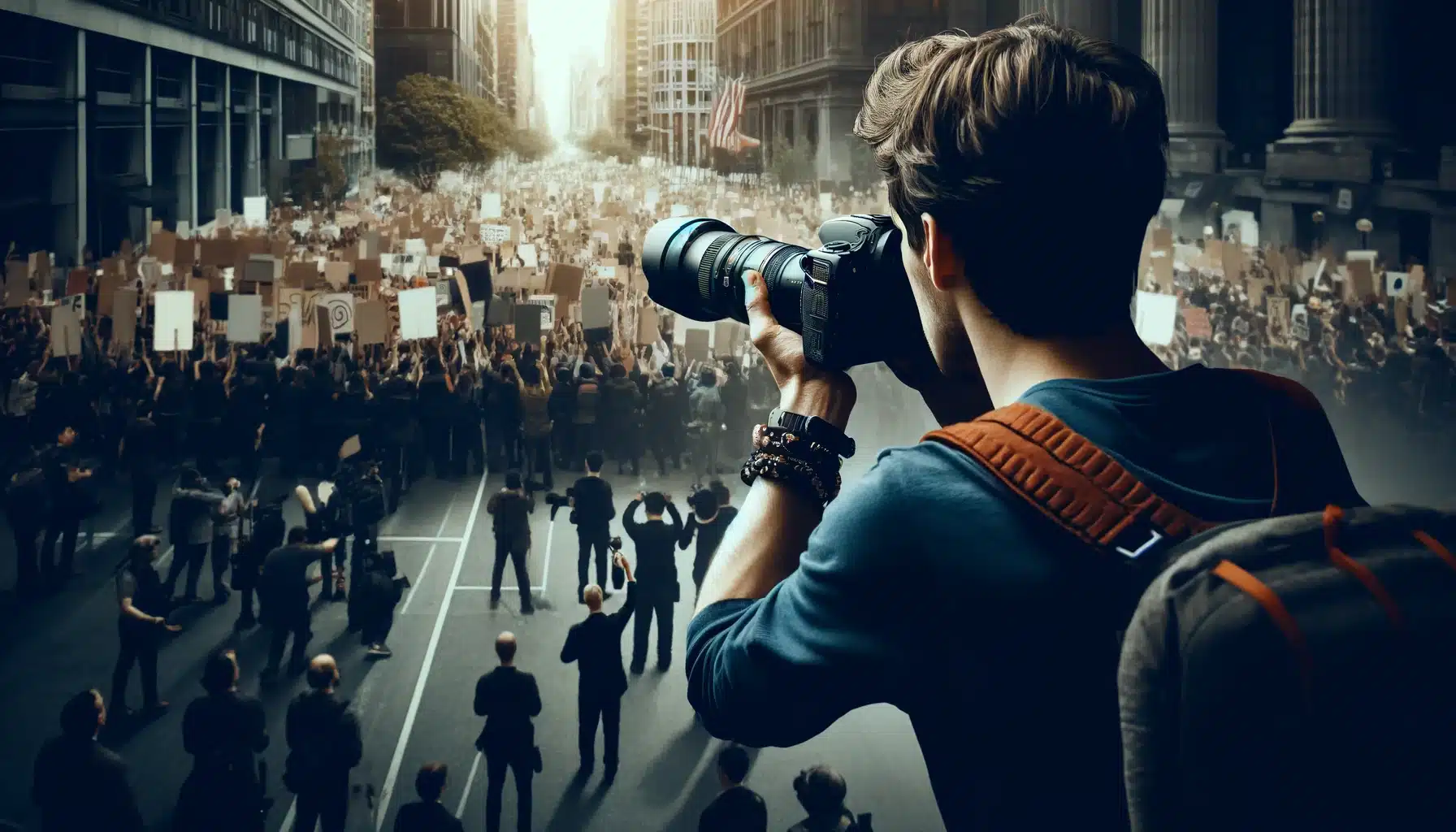
What is photojournalism? This dynamic field blends photography and journalism, capturing pivotal moments in human history with a click. From the bustling streets of global cities to the tense silence of war zones, photojournalism has evolved into a powerful form of storytelling that informs, influences, and inspires. It stands at the intersection of visual art and narrative journalism, offering a unique perspective on the world’s events. Utilizing tools like Adobe Photoshop, photojournalists enhance and refine their images, ensuring each photo not only tells a story accurately but also resonates visually with viewers.
Dive into this article to explore how photojournalists frame the truth in a single shot, preserving the raw emotions and realities of life through their lenses. Whether you’re a budding photographer, a seasoned journalist, or simply a curious reader, embarking on this journey into the heart of photojournalism will illuminate the profound impact images can have on our understanding of the world.
Table of Contents
Key Principles and Practices in Photojournalism
Here’s a detailed table highlighting the key principles and practices in photojournalism, incorporating the use of Adobe tools:
| Principle/Practice | Description | Purpose/Impact |
|---|---|---|
| Composition and Framing | Utilizing techniques like the rule of thirds, leading lines, and framing to create visually appealing and balanced images. | Enhances visual impact and helps convey the tales more effectively. |
| Capturing the Right Moment | Focusing on timing to capture dynamic or emotionally significant moments that define the subject or event. | Ensures the photo tells a fable or captures the essence of the moment, which is critical in news and documentary contexts. |
| Moral Codes | Adhering to guidelines that ensure fairness, respect, and dignity in capturing and presenting subjects. | Maintains public trust and credibility in journalistic content. |
| Editing and Processing | Selecting and refining photos to best represent the reality of the situation, including color correction, cropping, and minimal retouching. | Aids in clarifying and enhancing the narrative without compromising the authenticity of the images. |
| Specialization in Photography | Developing expertise in specific areas like sports, environment, or conflict to deepen the impact and authority of the visual content. | Allows for more focused and insightful coverage within specialized fields, leading to more informed public understanding. |
| Collaboration with Other Media | Working alongside writers, editors, and other media personnel to ensure that photos align with the textual narrative and overall media objectives. | Ensures coherence in storytelling and enhances the overall media message. |
| Adaptability to Environments | Operating effectively across diverse and often challenging environments, from conflict zones to natural disasters. | Ensures reliability and comprehensiveness in coverage, regardless of external conditions. |
These principles and practices underline the complexity and responsibility inherent in photojournalism, highlighting the blend of artistic skill, upright consideration, and journalistic integrity required to effectively document and narrate through visual media. For those looking to delve deeper into this field, comprehensive understanding and continuous learning are crucial. Exploring courses and training can significantly enhance both skill and understanding in these areas. So, let’s explore in detail:
Essential Techniques for Capturing Compelling Images
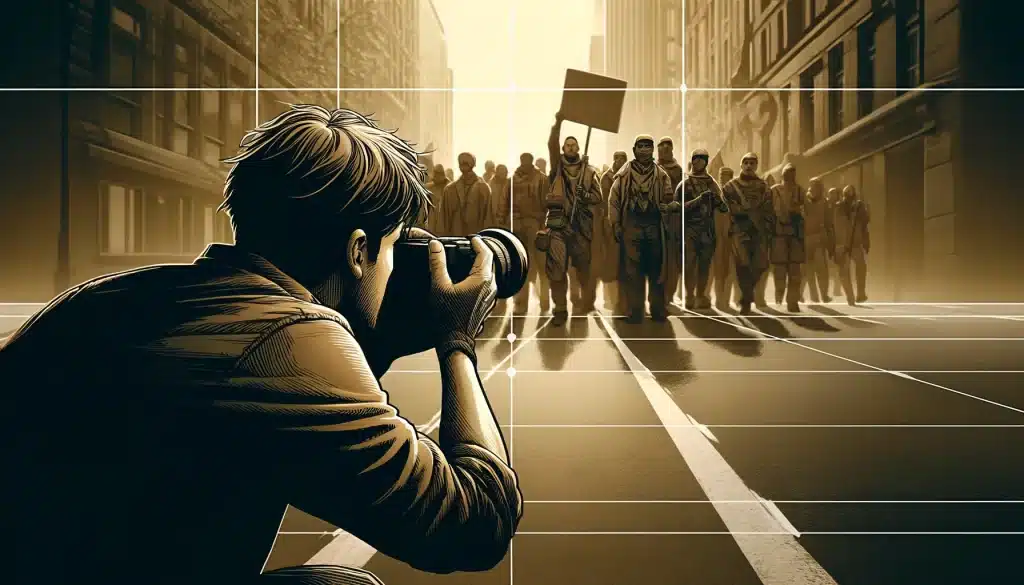
Photojournalism is an art that requires not only an eye for a good fable but also technical prowess and virtuous rigor. Here are some fundamental principles that every photojournalist should master:
- Composition and Framing: The rule of thirds is a classic composition technique that helps create engaging and balanced images. This involves dividing the frame into nine equal parts and placing the subject along these lines or their intersections. Moreover, framing your subject with natural surroundings can also add depth and context to the saga being told.
- Capturing the Right Moment: The essence of photojournalism lies in capturing the fleeting moments that tell a significant story. As this requires anticipation, patience, and readiness to capture actions and reactions that are often unpredictable but always telling.
- Maintaining Conduct Guidelines: Photojournalists carry the responsibility to present news in a truthful and sensitive manner. This includes respecting privacy, avoiding staged or manipulated scenes, and ensuring that the portrayal of subjects is dignified and honest. Furthermore, the authenticity and sensitivity in handling images, especially during tragic events, are critical for maintaining trust and integrity in journalism.
Advanced Techniques for Visual Storytelling
- Light and Shadow: Understanding and manipulating light can profoundly affect the mood and readability of an image. Photojournalists should master the use of natural light and know when to supplement with artificial lighting. Additionally, they should always aim for a natural look that doesn't distract from the subject.
- Perspective and Angles: Exploring different angles and perspectives can significantly alter the narrative of a photograph. Whether it’s a high angle to capture the scale of a scene or a low angle to provide a sense of grandeur, the chosen perspective should always enhance the story is telling.
- Environmental Context: Including elements of the environment in photos helps to set the scene and provides viewers with background necessary to understand the bigger picture. It’s essential to capture both the main subjects and their surroundings to tell a more comprehensive story.
- Emotional Impact: The ultimate goal of photojournalism is to connect with the audience on an emotional level. Through careful composition, timing, and perspective, photojournalists strive to evoke feelings that resonate with viewers, compelling them to engage more deeply with the content.
These principles not only guide photojournalists in creating impactful images but also ensure that the sagas they tell are honest, respectful, and true to the spirit of journalistic integrity. By adhering to these practices, photojournalists can continue to play their crucial role in documenting and shaping our understanding of the world.
Technological Impact on Photojournalism
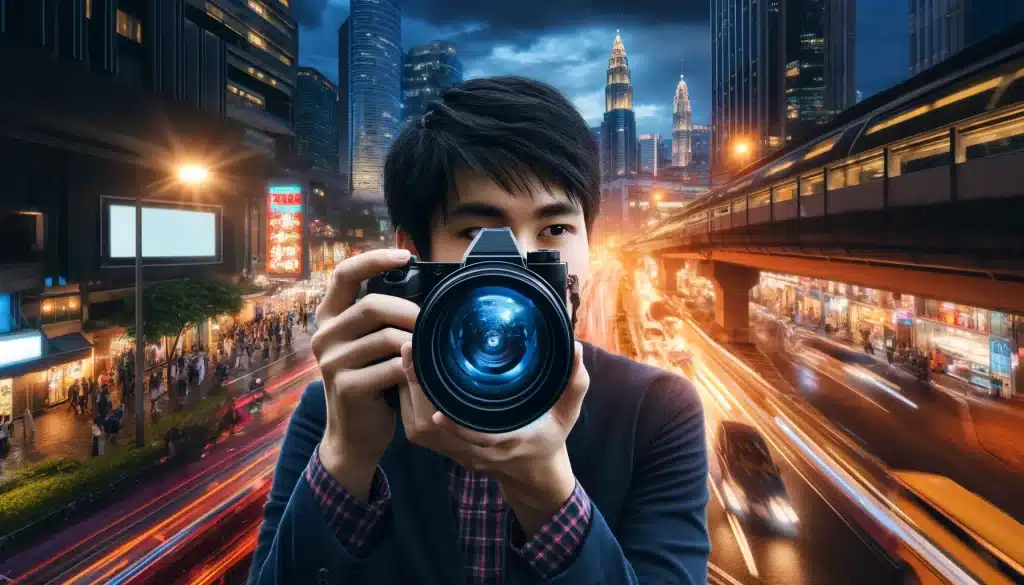
The technological revolution has irreversibly transformed the field of photojournalism, bridging gaps between the news and global audiences with unprecedented speed and efficiency. Innovations in digital technology, from advanced cameras to sophisticated editing software and platforms, have expanded the horizons for capturing and sharing visual news. The digital transformation has democratized information flow, enabling photojournalists to transmit images globally in moments. However, it also necessitates new skills and ethical vigilance.
Advancements in Camera Technology
Modern camera technology has significantly enhanced the quality and versatility of photojournalism. Innovations in camera sensitivity and resolution have expanded the range of conditions under which photojournalists can work, allowing for better images in low light and faster action shots. These improvements help photojournalists capture clearer, more detailed images that better convey the realities of the events they cover.
The Role of the Internet and Social Media
The internet and social media platforms have transformed the landscape of photojournalism by enabling faster and broader distribution of images. Additionally, they allow photojournalists to reach and interact with their audience directly, bypassing traditional media channels. Consequently, this has democratized information dissemination. Nonetheless, it also introduced challenges related to information overload and the spread of misinformation.
Ethical and Manipulative Challenges
With the advent of powerful editing software, the line between accurate representation and manipulation has become blurred. Photojournalists now face decent challenges in maintaining the authenticity of their images while resisting the pressure to alter photographs to attract more attention. Ensuring the integrity of photographic content remains a pivotal concern in the digital age.
Emerging Technologies: Drones and AI
The use of drones has opened up new perspectives in photojournalism, allowing for aerial shots that were previously impossible or prohibitively expensive to capture. Furthermore, advancements in artificial intelligence are beginning to play a role in how photojournalism is practiced. . This ranges from automating routine tasks like sorting and tagging photos to potentially identifying newsworthy events through pattern recognition.
Virtual Reality and Immersive Journalism
Virtual reality (VR) and augmented reality (AR) technologies are beginning to influence photojournalism, offering audiences immersive experiences of events. These technologies provide a deeper emotional connection to the tales being told, allowing viewers to feel as though they are part of the scene being photographed.
These technological advancements are reshaping the field of photojournalism, offering new tools and challenges that are continually evolving. As technology progresses, photojournalists must adapt to maintain the relevance and integrity of their work in capturing and conveying the truth.
Ethical Considerations in Photojournalism
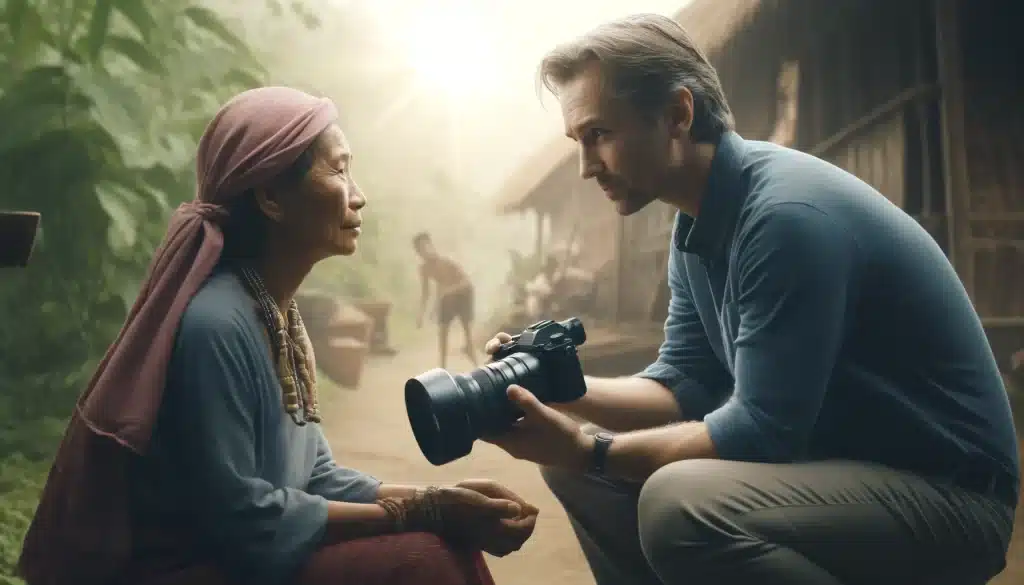
Core Principles of Ethical Photojournalism
Ethical photojournalism is vital to maintain trust and respect between the public and the media. It encompasses a set of practices that ensure the yarns photojournalists tell are truthful, respectful, and sensitive to the subjects and audiences alike.
- Informed Consent: It's crucial for photojournalists to obtain consent from their subjects when possible, especially in sensitive situations. This involves ensuring that subjects are aware of how their images will be used and agreeing to it without any coercion.
- Respect for Subjects: Ethical photojournalism involves portraying subjects with dignity and avoiding depictions that might further stigmatize or harm them. This includes safeguarding the identities of those who might be put at risk by the exposure.
- Accuracy and Authenticity: Photojournalists must strive to accurately represent their subjects and the contexts of their narratives. This includes avoiding misleading representations and manipulation of images that could distort the truth.
- Transparency and Accountability: Maintaining transparency about how images were obtained and the context in which they were captured is essential. This builds trust with the audience and holds the photojournalist accountable for their work.
Navigating Ethical Challenges
Photojournalists often face challenging situations where honest decisions are not clear cut. For example, during the Covid-19 pandemic, photographers had to balance the public’s need for information with the potential risk of spreading the virus, and invading the privacy of those affected.
- Handling Sensitive Topics: When covering crises like pandemics or conflicts, the just approach involves careful consideration of the impact of published images. This can include deciding not to publish overly graphic content that does not add to the public's understanding of the situation.
- Cultural Sensitivity: Understanding and respecting the cultural context of the subjects is crucial. This can affect how photojournalists interact with different communities and how they represent their tales to the world.
Principled Considerations in the Digital Age
The digital age has introduced new virtuous challenges for photojournalists, including the ease of image manipulation and the rapid spread of images across social media platforms. Ethical photojournalists must be vigilant about the authenticity of their images and the integrity of their storytelling.
- Avoiding Digital Manipulation: With the advanced capabilities of photo editing software, there is a fine line between enhancing an image for clarity and altering it in a way that misleads viewers. Ethical photojournalists should avoid significant alterations that could misrepresent the reality of the photograph.
- Dealing with Viral Content: The potential for images to go viral on social media means that photojournalists must be particularly careful about the accuracy and sensitivity of the images they share, as the impact is amplified and can be difficult to control once an image is widely disseminated.
Decent considerations in photojournalism are complex and require a careful balancing act between various factors. By adhering to these moral guidelines, photojournalists not only respect their subjects but also maintain the integrity and trustworthiness of their profession.
Roles and Responsibilities of a Photojournalist
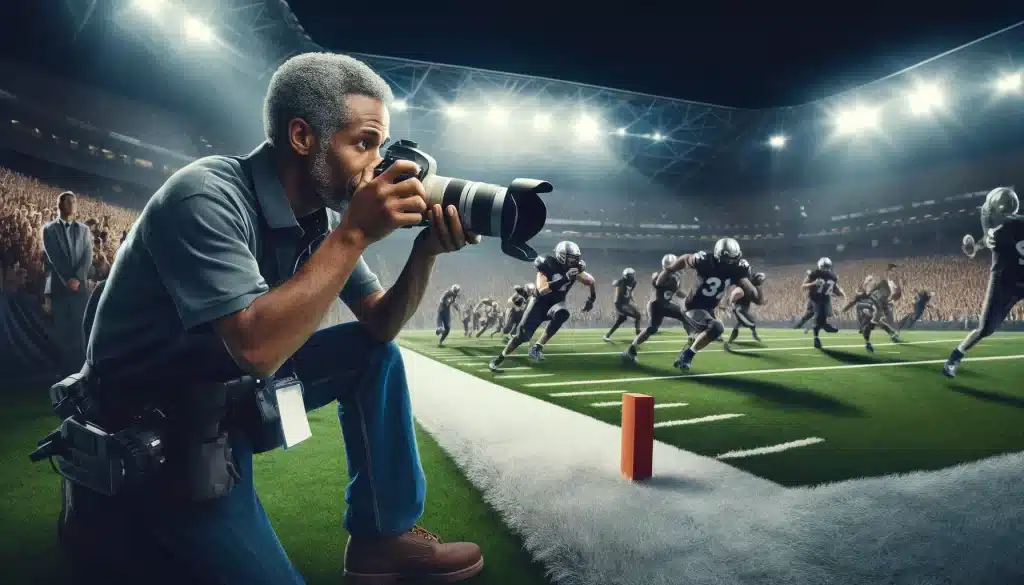
On-Site Reporting and Image Capture
A fundamental role of a photojournalist involves on-the-ground reporting. This includes capturing visual content at news events, protests, and sports events. They often work alongside reporters, providing visual chronicles that complement written and multimedia content. This requires a keen eye for detail, a strong sense of timing, and the ability to capture storytelling images under various conditions.
Editing and Image Processing
After capturing images, photojournalists spend considerable time reviewing and editing their work to select the most effective shots that convey the intended story. They utilize software tools to adjust exposure, enhance colors, and crop images to better frame the subject matter. This process is crucial to ensure the visual quality and storytelling impact of the photos.
Specialization in Diverse Fields
Photojournalists may specialize in various areas depending on their interests and the demands of their assignments:
- Documentary Photojournalists focus on longer-term projects that tell in-depth chronicles about social issues, cultures, or significant events.
- Environmental Photojournalists concentrate on issues like climate change, wildlife conservation, and other ecological topics.
- Sports Photojournalists capture the dynamic and intense moments of sports events, highlighting the emotion and action of the games.
Collaborative and Administrative Duties
In their day-to-day activities, photojournalists collaborate closely with reporters and editors to ensure that their photos align with the accompanying news episodes. They manage their schedules to meet deadlines and maintain a database of images for easy access and organizational purposes. For those working freelance, responsibilities also include negotiating the pricing for their photos, and managing their own business logistics.
Adapting to Varied Work Environments
The workplace of a photojournalist is highly dynamic and can vary greatly from day to day. They must be adaptable, ready to work in various conditions, including challenging weather, low light, and potentially hazardous situations. Their work might take them from bustling city events to remote natural disasters, requiring both physical endurance and mental resilience.
These roles and responsibilities outline a career that is both challenging and fulfilling, demanding creativity, just rigor, and a proactive approach to capturing and telling fables through images.
FAQ Answers for Photojournalism

What is the meaning of photojournalism?
Photojournalism is a form of journalism that uses photographs to tell news episodes. It combines photography with the journalistic pursuit of truth to visually communicate significant events and moments, often capturing them as they unfold in real-time. Photojournalism is distinct from other forms of photography because it focuses on truthful, objective, and often spontaneous snapshots that contribute to the historical record.
What do you do in photojournalism?
In photojournalism, you capture images that tell tales or provide information about events, people, or other relevant subjects. This involves not only shooting photos but also selecting, editing, and sometimes captioning them to fit within the narrative of news episodes. Photojournalists often work on assignments for newspapers, magazines, and digital media outlets, and may cover a variety of subjects including news events, sports, documentaries, and environmental issues.
What are the 5 basics of photojournalism?
- Timeliness: The images are relevant to recent events.
- Objectivity: The photos should be a factual, unbiased representation of the event.
- Narrative: The images should collectively tell a story.
- Ethics: Righteous practices should be maintained, respecting the dignity and truth of the subjects without manipulation.
- Aesthetics: Despite the focus on truth, photographic quality and composition cannot be ignored as they enhance the storytelling.
What are the three qualities of photojournalism?
- Accuracy: Ensuring that the photographs faithfully represent the scene or event.
- Impact: Capturing moments that are powerful and evoke an emotional response from the audience.
- Awareness: Having an understanding of the context surrounding the event being photographed, which helps in conveying the episode more effectively?
Conclusion

In the dynamic world of capturing reality through a lens, the onus rests heavily on those behind the camera to shape public perception with sincerity and creativity. Personally, I recall an assignment documenting a local art festival, where the vibrancy and emotion were palpable. I focused on a young painter, her eyes flickering with the reflection of the colorful canvases. This single frame not only highlighted her passion but also symbolized the spirit of the entire festival. Such instances reinforce the profound impact that skilled documentation can have in bridging diverse cultures and accounts.
For enthusiast’s eager to harness the power of their cameras and elevate their skills, I highly recommend exploring our comprehensive courses on Photoshop and Lightroom. These platforms offer the tools and techniques necessary to enhance your ability to tell compelling narratives visually. Start your journey today and learn to capture the world in its true essence at Photoshop Course and Lightroom Course. Dive deep into the art and craft of photography with us!
If the “What is Photojournalism?” article has helped you, then Like and Share it with your friends!
Have a nice photoshoot!
Read more about: Photo Editing with Lightroom and Photoshop
Course
Light Effect Photoshop
Lightroom Course 2025
Adobe Photoshop Course 2025
Photo Editing Course


Download Your Free Guide Now!
Discover the secrets of photography with our printable guide! Master essential techniques like aperture, shutter speed, and ISO to create stunning images. Get your free printable PDF now and start turning your snapshots into masterpieces!







